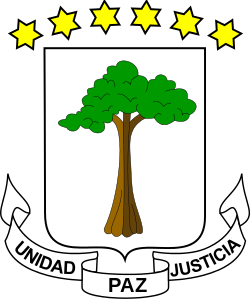1979 Equatorial Guinea coup d'état
| 1979 Equatorial Guinea coup d'état | |||||||
|---|---|---|---|---|---|---|---|
 | |||||||
| |||||||
| Belligerents | |||||||
|
| Opposition forces | ||||||
| Commanders and leaders | |||||||
| Francisco Macías Nguema | Teodoro Obiang Nguema Mbasogo | ||||||
Part of a series on the |
|---|
| History of Equatorial Guinea |
 |
| Chronological |
|
|
The 1979 Equatorial Guinea coup d'état happened on August 3, 1979, when President Francisco Macías Nguema's nephew, Teodoro Obiang Nguema Mbasogo, overthrew him in a bloody coup. He sentenced his uncle to death for the crime of genocide against the Bubi people and other crimes committed. Macías Nguema was executed by firing squad on September 29, 1979. Teodoro has remained President since then.
Background
After Spain granted Equatorial Guinea independence in 1968, a power struggle between Macías and Atanasio Ndongo Miyone led to the former assuming the presidency. Ndongo attempted a coup the following year; he was captured and executed, and the backlash to the presumed Spanish involvement in the coup led to a mass exodus of Spanish natives from the country. Macías subsequently consolidated national political authority, making himself the absolute dictator of the country. Macías' reign as dictator was marked by his extensive use of state violence against his political opponents, Nigerian migrant workers, and minority ethnic groups, particularly the Bubi people. An estimated 35,000-50,000 people died during Macías' time in power, many of them in mass killings or imprisonment in the country's notorious prison camps, and by 1979 25% of the country's population lived in exile.[1]
The coup
Obiang, Macías' nephew and deputy defense minister, overthrew Macías on August 3, 1979. The coup was backed by the nation's military and Macías' Cuban palace guard; several foreign embassies, including those of Spain and the United States, were aware of the plot in advance and provided financial humanitarian aid in its aftermath. Upon his ouster, Macías and his personal bodyguard fled to Macías' home village of Nzeng-Ayong and took up residence in a fortified bunker protected by military loyalists. The ensuing conflict between Obiang and Macías' forces killed 400 people; it ended when Macías burned his personal treasury and fled toward the Cameroon border. A force led by naval commander Florencio Maye captured Macías on August 18, and he and six of his allies were executed on September 29.[1] Obiang has remained president of Equatorial Guinea since the coup.[2]
See also
References
- 1 2 Baynham, Simon (February 1980). "Equatorial Guinea: The Terror and the Coup". The World Today. 36 (2): 65–71. JSTOR 40395170. (registration required (help)).
- ↑ "Equatorial Guinea". The World Factbook. Central Intelligence Agency.